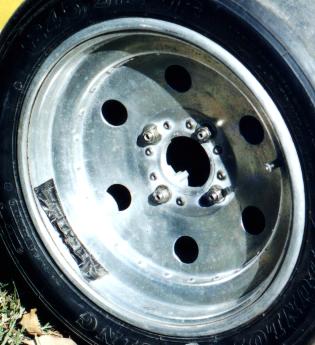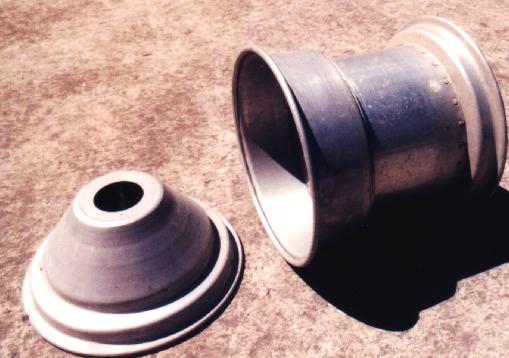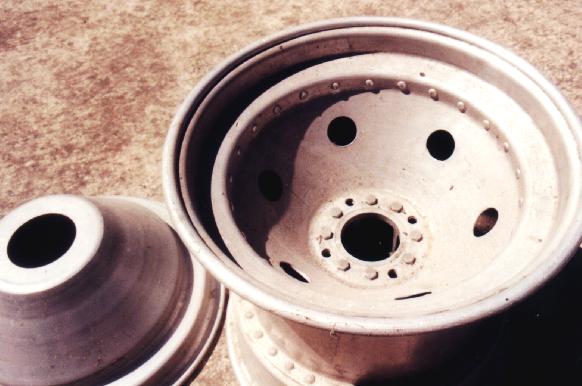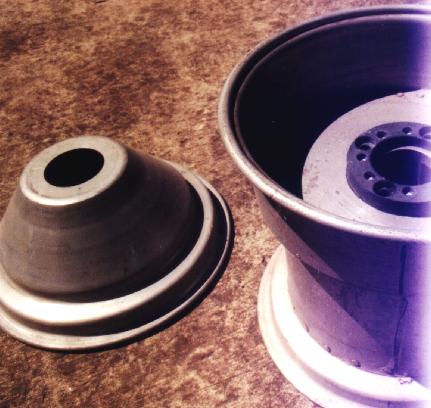The original monocoque wheel was produced starting in 1965 by Chassis Engineering Company, originally of National City, CA and later Santee, CA. It was designed by Fred Puhn, a racing car designer (the Quasar, a SCCA D Sports racer) and author (How to Make Your Car Handle, 1981, and The Brake Handbook ,1985). Fred's partner at Chassis Engineering was Carter Penley Jr., a fiberglass and carbon fiber specialist, who later went on to form Penley Sports, one of the originators of carbon fiber golf club shafts.
The racing wheel portion of Chassis Engineering was acquired by David Boone in 1976 and renamed Monocoque Wheel Company. Although the original monocoque wheel had been designed for sports racers and formula cars, road racers had actually become a relatively small part of the company's market — drag racers early on discovered the light and strong wheels and became Monocoque Wheel's biggest customer base.
The production process for the wheel was pretty interesting:
1) Each half of the wheel was formed from 3/16" sheet T-6061 aluminum spun at relatively low speed on a huge lathe using rollers over a male mandrel consisting of multiple sections which could be added or taken away to produce wheel halves of different depths. A giant torch was used to soften and anneal the aluminum during the spinning process. This process took a lot of skill to avoid thinning the material in the outer bead areas, but properly done, the overall thickness of the aluminum could be maintained within a few thousands. It also took a lot of fortitude: working a 30" diameter spinning hunk of metal in front of a 2 foot flame in the 105F summers of Santee, CA was not for the faint of heart.
2) After spinning, the rim edge was rough trimmed and heat treated to a T6 level.
3) The raw wheel halves where anodized, or occasionally, powder coated.
4) The heat-treated and anodized wheel halves where machined on a precision lathe to true up all of the mating faces. This was a critical part of the process overlooked by some of the cheaper imitations.
5) An aluminum billet spacer was individually machined to match the dimensions of the two halves. Optionally, 1" or 1-1/2" lightening holes where drilled in the half faces between the center hub and the rim bolts.
6) The wheel was bolted together using aircraft grade hardware and the rim bead edges where trimmed true to the center mounting pad area.
7) The center joint crevice was sealed with silicone and an o-ring.
Here's what the classic Monocoque Wheel Company wheel looked like in cross section:

David expanded the business throughout the 70's, 80's and 90's, improving quality and introducing innovations like a 3-piece modular wheel with spun outer rims and a cast or billet center and an extremely light 17" spindle mount front drag racing wheel (under 6 lbs each versus over 7 lbs for competitors products).
Over the last few years Monocoque Wheel Company found it harder and harder to compete against larger firms like Centerline who could afford to make little or nothing on their racing product — essentially operating it as loss-leader marketing for their much bigger street market. David was a racer at heart and never really wanted to produce wheels for the street. David closed Monocoque Wheel Company in 2002.



















